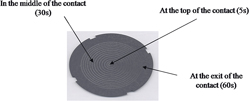No CrossRef data available.
Published online by Cambridge University Press: 08 February 2017

In a hot forming process, the study of the interface tool/product proves important. This study focuses on the influence of the third body in the case of pin-on-disc in an open contact. The objective of this work was to identify the third body-particle circulation mechanisms at high temperatures. The “wear and friction” tests were conducted with an open sliding contact on pairs of X40CrMoV5/Fe360B steels under a normal force of 70 N at 600 °C and with a speed of rotation of the disc of 50 rev/min. The pin material was X40CrMoV5 (AISI H13) steel and the disc material was Fe360B steel. Scanning electronic microscope, energy-dispersive spectroscopy (EDS), and X-ray diffractometer explored the development surface damage and oxides tribo-oxides. It was concluded that various types of the third body particles were present in the contact. The wear mechanism on the X40CrMoV5 pin in a high temperature contact is proposed.
Contributing Editor: Jürgen Eckert